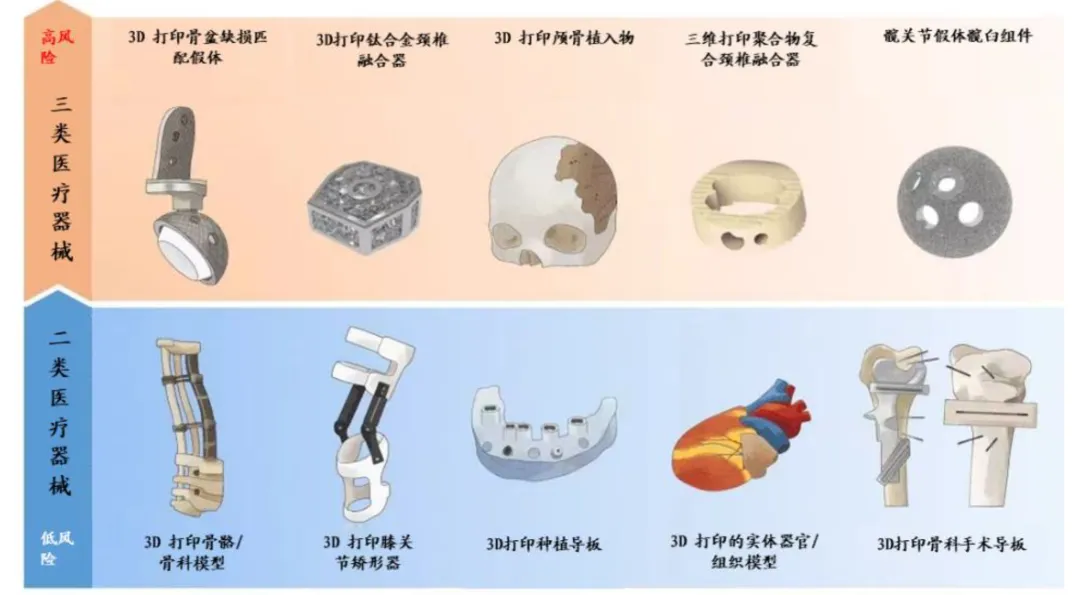 Cutting-edge High-value Consumables Editor – Gao GaoReport | Insights | Discussion Group
Cutting-edge High-value Consumables Editor – Gao GaoReport | Insights | Discussion Group

↑ Click the image to view conference details ↑
↑ Long press the image to register for the conference ↑
In the current era of rapid technological advancement, medical 3D printing, as an innovative technology, is gradually transforming the landscape of the healthcare industry. From surgical assistance to medical device manufacturing, from drug development to bioprinting, medical 3D printing demonstrates immense application value and market potential. Today, let us delve into the classification of medical 3D printing and the current market situation.01
Classification of Medical 3D Printing
▌Classification by Printing Material1. Metal Materials: Represented by titanium alloys, these materials are ideal for manufacturing implants such as hip and knee prostheses due to their high strength, good biocompatibility, and corrosion resistance. Metal 3D printing can precisely manufacture complex internal structures, promoting the integration of bone and implants, thereby enhancing implantation outcomes.2. Polymer Materials: Common examples include photosensitive resins and polylactic acid (PLA). Photosensitive resins are often used to create high-precision medical models and surgical guides, achieving fine detail reproduction through photopolymerization; PLA, due to its biodegradability, has wide applications in absorbable sutures and tissue engineering scaffolds.
3. Biological Materials: “Bio-inks” are key to bioprinting, composed of cells, growth factors, and biological gels. These materials can be used to print biological tissues and organs, such as skin for burn treatment and blood vessels for cardiovascular disease treatment, bringing new hope to regenerative medicine.
▌Classification by Forming Process
1. Photopolymerization: SLA (Stereolithography Apparatus) is a typical representative of this process, utilizing lasers or ultraviolet light to cure photosensitive resin layer by layer, thereby constructing three-dimensional objects. This process has high precision and good surface quality, suitable for manufacturing complex medical models and small medical devices.
2. Fused Deposition Modeling: This process involves heating thermoplastic materials to a molten state, extruding them through a nozzle, and layering them according to a preset path to form a three-dimensional entity. This method is commonly used for manufacturing plastic medical devices and prosthetics, with relatively low equipment costs and simpler operation.
3. Powder Bed Fusion: Represented by Selective Laser Melting (SLM), this process uses high-energy laser beams to melt and sinter metal powders layer by layer, producing high-performance metal parts. In the medical field, it is primarily used for manufacturing metal implants, resulting in products with high density and strength.
4. Jetting: For example, the three-dimensional powder binding process involves spraying a binder onto a powder bed, selectively binding the powder together to form an object. This can be used to manufacture medical models and dental restorations from ceramic and plaster materials.
5. Extrusion: This method can print liquid and gel-like materials with precision ranging from 20 to 100 microns. It is commonly used for manufacturing complex polymer medical devices and surgical training models, and also has significant applications in bioprinting.
 02
02
Introduction to 3D Printing Raw Materials
The main categories of 3D printing raw materials include metal materials, engineering plastics, and photosensitive resin materials.
 03
03
Market Analysis of Medical 3D Printing
The medical 3D printing market is showing strong growth. By 2024, the global market size for 3D printed medical devices is expected to reach $3.79 billion, with a projected compound annual growth rate (CAGR) of 16.3% over the next five years. According to SNS Insider, the global market value for 3D printed medical devices was $2.69 billion in 2023, and it is expected to reach $11.46 billion by 2032, with a CAGR of 17.5% from 2024 to 2032. Among these, the dental field is one of the more mature application areas for medical 3D printing technology, with the global dental 3D printing market size around $3.2 billion in 2023, projected to soar to $19.6 billion by 2032, with a staggering CAGR of 23.03%.
04
Applications of Medical 3D Printing
Medical 3D printing is divided into two categories: non-biological 3D printing and biological 3D printing. Compared to biological 3D printing, the principles of non-biological 3D printing are relatively simple, and the required materials are more readily available, thus its applications in the medical field are already quite widespread. Most products of non-biological 3D printing do not possess biocompatibility and can generally be classified as medical devices.
▌Specific applications include:
① Manufacturing of personalized prosthetics, applicable in orthopedics, dentistry, and plastic surgery;
② Complex structures and difficult-to-process medical device products, including both implants and non-implants, such as porous hip joints and medical models simulating human organs.

Main Types of 3D Printed Medical Devices
Biological 3D printing is based on active biomaterials, tissue engineering, MRI and CT technologies, and 3D reconstruction technologies, aiming to print living organs.
05
Review of Domestic 3D Printing Companies
 The order of the list does not indicate ranking
The order of the list does not indicate ranking
Source: Zhongzhi Medical Materials


 Selected Past Articles
Selected Past Articles
●Essential Websites for Consumables (Bookmark)
●Summary of Interventional Catheter Materials
●Directory of Innovative Medical Devices
●Understanding the Competitive Landscape of the Domestic Medical Device Market
●Global Cardiovascular Device Market: Status, Trends, Analysis, and Outlook
●Global Orthopedic Implant Market: Status, Trends, Analysis, and Outlook
●Global Peripheral Vascular Device Market: Status, Trends, Analysis, and Outlook
●Global Interventional Cardiology Device Market: Status, Trends, Analysis, and Outlook

[Disclaimer] The content of this public account is for reference only and does not constitute medical, investment, or business advice. Readers should verify the information and make cautious decisions. Some content is sourced from the internet; if there is any infringement, please contact us for resolution.
